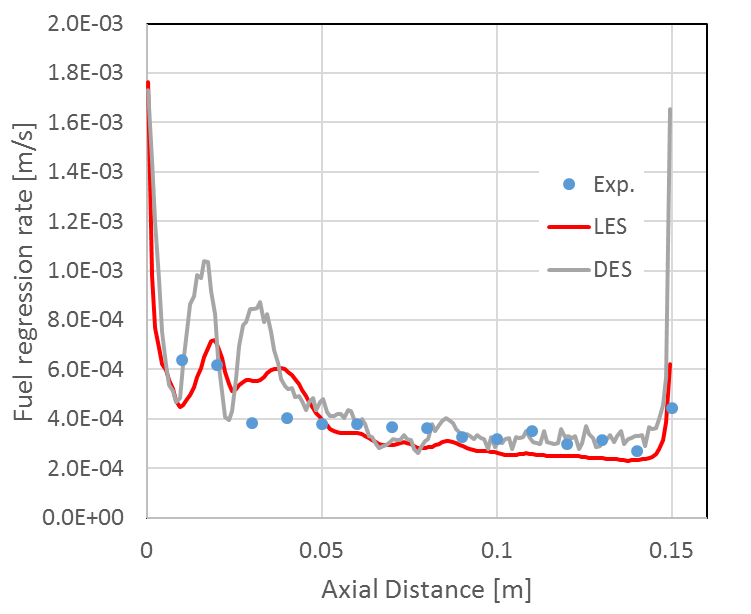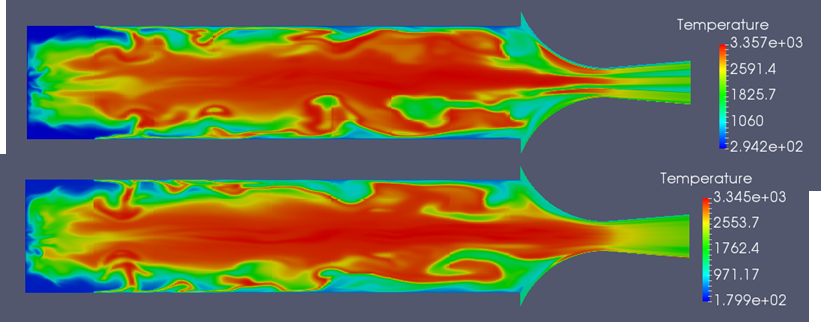Research on Space Propulsion Flow Dynamics
JAXA Supercomputer System Annual Report April 2016-March 2017
Report Number: R16E0113
- Responsible Representative: Eiichi Sato(Department of Space Flight Systems, Institute of Space and Astronautical Science, Japan Aerospace Exploration Agency)
- Contact Information: Mikiroh Motoe(motoe.mikiroh@jaxa.jp)
- Members: Toru Shimada, Mikiroh Motoe, Tomoki Matsuno
- Subject Category: Space(Space transportation,Satellite utilization,Space engineering)
Abstract
It is natural and logical to require safe and economic space transportation for the realization of sustainably growing future space economy. However, the current space transportation system cannot be as safe as the current aircraft because the current rocket has essential explosive nature of the propellant. In order to realize non-explosive safe rocket, we suggest A-SOFT hybrid rocket and research on computer simulation of swirling turbulent combustion field in hybrid rocket engine for realization of this type of rocket.
Goal
By studying hybrid rocket, which is an essentially non-explosive propulsion system, we make effort for safe and economic space transportation for the realization of sustainably growing future space economy.
Objective
Our goal is to establish analysis technology of swirling turbulent combustion phenomena in a hybrid rocket chamber, which means detail analysis method to understand the mechanism and analysis tool useful for its design.
References and Links
N/A
Use of the Supercomputer
We will establish the stable and unstable numerical analysis technology for the swirling turbulent combustion field in hybrid rocket combustion chamber, and understand its characteristics and unique physical phenomena for actual development by using this technology.
Necessity of the Supercomputer
It is impossible to conduct practical numerical analysis for turbulent combustion phenomena with general computer from the perspective of computing speed and memory capacity. Therefore high speed and large scale analysis with super computer is necessary for development of hybrid rocket.
Achievements of the Year
In order to establish scheme of unsteady combustion simulation for hybrid rocket, Detached-eddy simulation (DES) have been conducted to the rocket and its results are compared with results of Large-eddy Simulation (LES). Fig.1 shows numerical estimations and an experimental result of axial distribution of fuel regression rate of swirling-oxidizer-flow-type hybrid rocket (numerical estimations are instantaneous value). Fig.2 shows contours of temperature that are obtained from LES and DES. These result show that both methods can conduct reasonable simulation for such kind of hybrid rocket.
Calculation practice using JSS2 has been conducted in order to make parallel computation program to simulate constant swirling turbulent combustion field in hybrid rocket engine.
Publications
Presentations
1) ICFD2016
Computational Information
- Parallelization Methods: Process Parallelization,Thread Parallelization
- Process Parallelization Methods: MPI,n/a
- Thread Parallelization Methods: n/a,OpenMP
- Number of Processes: 680,1
- Number of Threads per Process: 1,2
- Number of Nodes Used: 45,1
- Elapsed Time per Case (Hours): 240, 6
- Number of Cases: 3, 20
Resources Used
Total Amount of Virtual Cost(Yen): 3,719,261
Breakdown List by Resources
| System Name | Amount of Core Time(core x hours) | Virtual Cost(Yen) |
|---|---|---|
| SORA-MA | 2,242,986.67 | 3,529,309 |
| SORA-PP | 13,173.42 | 112,474 |
| SORA-LM | 0.00 | 0 |
| SORA-TPP | 0.00 | 0 |
| File System Name | Storage assigned(GiB) | Virtual Cost(Yen) |
|---|---|---|
| /home | 1,194.13 | 11,264 |
| /data | 1,199.09 | 11,311 |
| /ltmp | 4,752.61 | 44,831 |
| Archiving System Name | Storage used(TiB) | Virtual Cost(Yen) |
|---|---|---|
| J-SPACE | 3.26 | 10,070 |
Note: Virtual Cost=amount of cost, using the unit price list of JAXA Facility Utilization program(2016)
JAXA Supercomputer System Annual Report April 2016-March 2017




